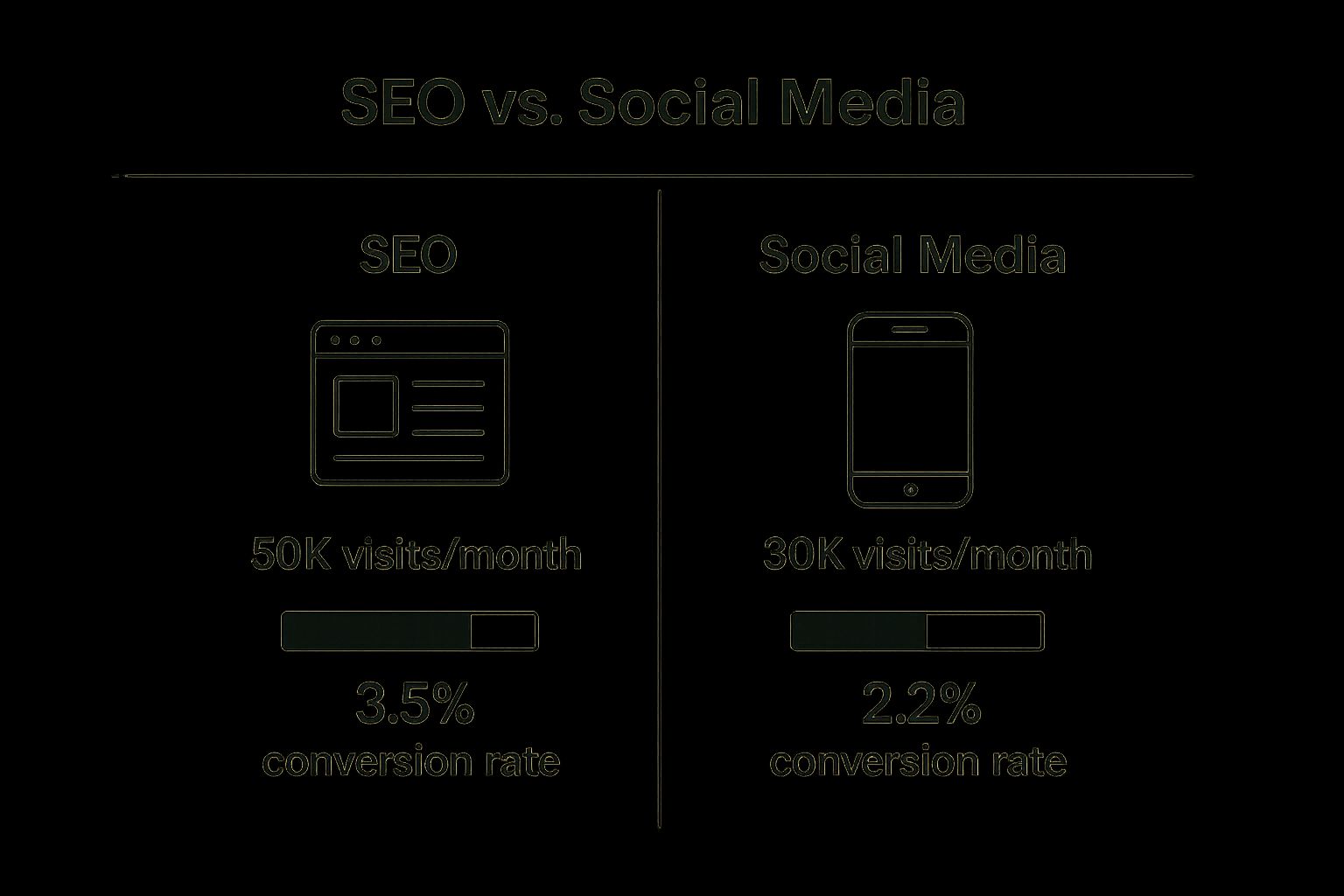The Modern Inbound Sales Funnel: Beyond the Basics

The traditional inbound sales funnel, often pictured as a linear journey from awareness to purchase, has changed. The modern buyer's journey is far more complex, a web of interactions across multiple touchpoints. This means businesses must adapt their strategies. Instead of forcing prospects down a rigid path, the focus now is on building relationships and offering value at every turn.
From Interruption to Engagement
The key difference is a move from interruption-based marketing to strategies centered around engagement. Instead of disruptive ads, think of it as starting a conversation with potential customers. This means creating valuable content that addresses their needs and pain points at each stage of their journey.
For example, instead of a generic product pitch, offer a helpful guide or a free tool related to their industry. This helps establish your expertise and builds trust, making prospects more open to your message. Understanding the differences between B2B and B2C marketing is crucial for tailoring your inbound sales funnel effectively. This shift allows businesses to nurture leads more effectively and build stronger relationships with their target audience.
The Power of Value-Driven Content
In this evolving landscape, content becomes the driving force of your inbound sales funnel. It's not about just creating any content; it's about crafting targeted pieces that resonate with your ideal customer. Each piece should have a specific purpose, guiding prospects to the next stage.
As of 2025, 48% of marketers worldwide have prioritized improving their sales funnel strategies. This underscores just how vital optimizing each stage of the funnel is for revenue growth. The widespread adoption of sales funnel technology, with nearly 570,000 websites globally using at least one such tool, speaks volumes. More statistics on sales funnels can be found here. This widespread use highlights the importance of a well-structured inbound sales funnel in today's competitive marketplace.
Embracing the Flywheel Model
The modern inbound sales funnel isn't just about acquisition; it's about turning customers into advocates. This is often visualized as a flywheel, where satisfied customers generate momentum, driving further engagement and attracting new prospects.
This requires a continued focus on customer engagement and support, even after the sale. This creates a self-sustaining growth cycle, where happy customers become your best marketers. By consistently delivering value and exceeding expectations, you can transform your inbound sales funnel into a powerful engine for growth. This flywheel approach recognizes the importance of customer retention and advocacy for long-term success.
Creating Content That Moves Prospects Through Your Funnel
Creating valuable content is the foundation of any successful inbound sales funnel. But it's not enough to just create content. You need to strategically develop content designed to guide prospects through each stage of the funnel, from initial awareness to the final purchase decision. This requires a deep understanding of your target audience's needs and motivations at each touchpoint in their journey.
Content for the Awareness Stage
At the top of the funnel, prospects are just beginning to recognize a problem or need. Your content should focus on educating them about this problem, offering helpful insights and resources without directly promoting your product. Think blog posts, infographics, and social media updates that provide valuable information related to their industry or pain points. For example, if you sell project management software, you could create content around topics like "5 Signs Your Team Needs Better Project Management" or "The Ultimate Guide to Remote Team Collaboration."
These pieces offer value upfront and establish your brand as a knowledgeable resource.
Content for the Consideration Stage
As prospects move into the consideration stage, they actively research solutions to their problem. Your content should position your product as a potential solution by highlighting its features and benefits. Consider creating case studies, webinars, and comparison guides that showcase your product's value proposition. Additionally, offering free tools or resources, like templates or calculators, can further engage prospects while capturing valuable lead information. You might be interested in: How to master B2B sales lead generation.
This stage focuses on demonstrating how your product can specifically address their needs.
Content for the Decision Stage
In the decision stage, prospects are ready to buy but may still be comparing different options. Your content should build trust and address any remaining objections. Testimonials, product demos, and free trials are particularly effective at this stage. Offer clear and concise information about pricing and support, empowering prospects to make informed decisions. This is where you solidify your product as the best choice.
Analyzing Content Performance and Driving Conversions
Data plays a vital role in understanding which content resonates most with your audience at each stage. Analyzing metrics helps you optimize content for specific platforms and target the right audience for every stage of your inbound sales funnel.
To understand this better, let's look at a comparison of two key inbound marketing strategies: SEO and social media.

The infographic above illustrates the traffic and conversion differences between these two channels. In this example, SEO drives 50,000 visits per month with a 3.5% conversion rate, while social media generates 30,000 visits with a 2.2% conversion rate. Although SEO drives more traffic with a higher conversion rate in this specific scenario, both channels play crucial roles in a comprehensive inbound strategy.
To further illustrate how content types align with the sales funnel stages, the following table offers a strategic breakdown:
Effective Content Types by Funnel Stage
| Funnel Stage | Primary Content Types | Key Metrics | Conversion Goals |
|---|---|---|---|
| Awareness | Blog posts, infographics, social media updates | Website traffic, social media engagement | Generate leads, build brand awareness |
| Consideration | Case studies, webinars, comparison guides, free tools/resources | Lead captures, engagement with gated content | Qualify leads, nurture prospects |
| Decision | Testimonials, product demos, free trials, pricing/support information | Conversion rates, sales qualified leads | Close deals, customer acquisition |
This table demonstrates how different content formats can be used strategically at each stage to drive prospects towards a purchase. By understanding these nuances and adapting your content strategy accordingly, you can maximize the impact of your inbound sales funnel. This iterative process of creating, analyzing, and refining your content strategy ensures you’re continually improving its effectiveness in moving prospects toward conversion.
Eliminating Friction Points That Kill Conversions

A successful inbound sales funnel operates smoothly, guiding potential customers towards a conversion. But even well-designed funnels can have friction points, causing prospects to abandon the process. This section explores how to identify and eliminate these hidden barriers, improving your inbound sales funnel's performance.
Identifying Common Friction Points
Friction can come from various sources, including psychological triggers, technical issues, or content mismatches. For example, a long, complicated form asking for too much information can discourage prospects.
Slow page loading times and confusing website navigation can also frustrate users, leading them to leave. If your content doesn't address a prospect's needs at their current stage in the buying process, they are more likely to disengage. Pinpointing these friction points is the first step to optimizing your funnel.
Psychological Barriers and Solutions
Understanding prospect psychology is crucial for reducing friction. Hesitation often stems from uncertainty or a perceived lack of value. Unclear pricing or hidden fees can erode trust.
The solution is transparency. Clearly communicate your value proposition at every stage. Tools like a testimonial generator can create engaging testimonials, boosting trust and credibility.
Make sure your calls to action are compelling and feel like natural next steps, not aggressive sales pitches. This builds trust and encourages prospects to continue.
Technical Issues and User Experience
Technical problems can significantly impact conversion rates. A slow landing page can frustrate users, while broken links or forms can completely stop the process. Optimizing your website for speed and ensuring all technical elements work perfectly is essential.
Pay close attention to user experience (UX). Intuitive navigation, clear calls to action, and a mobile-responsive design are essential for a smooth experience. This makes it easy for prospects to navigate your funnel and complete desired actions. For more information, read How to nurture leads and close more deals.
Content Disconnects and Building Trust
Your content should guide prospects seamlessly through the inbound sales funnel, addressing their specific needs at each stage. A disconnect between the content and the buyer's journey creates confusion and reduces trust.
For example, presenting product-focused content too early, during the awareness stage, can feel pushy. Instead, focus on educational content that provides value and positions you as an expert. As prospects move down the funnel, tailor your content to their evolving needs, building trust and confidence in your solution.
Conversion rates vary at each funnel stage, with B2B benchmarks providing valuable targets. According to FirstPageSage and Gartner, average B2B conversion rates are: 25% to 35% for lead to marketing qualified lead (MQL), 13% to 26% for MQL to sales qualified lead (SQL), 50% to 62% for SQL to opportunity, and 15% to 30% for opportunity to close. More detailed statistics are available here.
By addressing these friction points, you create an inbound sales funnel that attracts and effectively converts prospects into loyal customers. This requires continuous analysis, testing, and optimization to maintain peak funnel performance.
Building Your Inbound Sales Funnel Technology Stack
Building a successful inbound sales funnel requires more than just compelling content and a solid strategy. You need the right technology stack. This isn't about chasing the newest, shiniest tools, but about strategically selecting solutions that genuinely enhance your funnel's performance. Consider your specific business needs, your budget, and how well potential tools integrate with your existing systems.
Choosing the Right Tools for Each Stage
Different stages of your inbound sales funnel benefit from different technologies. In the awareness stage, tools like SEO software and social media management platforms, such as Hootsuite, help you reach a broader audience. During the consideration stage, tools like email marketing platforms (e.g., Mailchimp) and webinar software (e.g., GoTo Webinar) nurture leads and provide valuable content. Finally, in the decision stage, CRM systems (e.g., Salesforce) and sales automation tools, such as Salesloop.io, help close deals and track customer interactions.
-
CRM (Customer Relationship Management): A core component for managing customer interactions and data throughout the entire funnel. A CRM centralizes information and offers valuable insights into customer behavior. Salesloop.io, while primarily a sales outreach platform, integrates with various CRM systems for streamlined data flow and improved targeting.
-
Marketing Automation: Automates repetitive marketing tasks, like email sequences and social media posting. This frees up your team to focus on strategy and personalized engagement.
-
Analytics Platforms: Provide essential data on funnel performance. Use analytics platforms to identify areas for improvement and track key metrics.
-
Communication Tools: Facilitate direct engagement with prospects through various channels, including live chat and email.
Implementing and Integrating Your Tech Stack
Effective implementation is as crucial as selecting the right tools. A poorly implemented system can create more headaches than it solves. Begin with a clear understanding of your needs and choose tools that integrate seamlessly with one another. This prevents data silos and ensures smooth information flow across your sales process. Implementing your chosen technology in phases can also minimize disruptions and allows for adjustments along the way.
To help visualize the available options, consider the table below, which outlines key technologies and their roles within an inbound sales funnel:
To help you choose the right tools, we've compiled a comparison table outlining key features and considerations for each technology category.
Essential Inbound Sales Funnel Technology Stack: A comprehensive comparison of key technology solutions for each component of your inbound sales funnel, helping you select the right tools based on business size, budget, and requirements.
| Technology Category | Key Features | Best For | Integration Capabilities | Price Range |
|---|---|---|---|---|
| CRM | Contact management, lead tracking, sales reporting, deal management | All business sizes | Email marketing, marketing automation, sales automation, customer support | Varies widely (from free to thousands of dollars per month) |
| Marketing Automation | Email marketing, lead nurturing, social media scheduling, landing page creation | Small to large businesses | CRM, analytics platforms, social media platforms | Varies widely (from free trials to enterprise-level pricing) |
| Analytics Platforms | Website analytics, campaign tracking, conversion rate optimization, A/B testing | All business sizes | CRM, marketing automation, advertising platforms | Varies widely (from free tools to premium subscriptions) |
| Communication Tools | Live chat, email marketing, social media engagement, video conferencing | All business sizes | CRM, marketing automation, helpdesk software | Varies widely (from free options to paid plans with advanced features) |
This table offers a starting point for evaluating different solutions and aligning them with your business needs. Remember to research specific providers and compare their offerings to find the best fit.
Future-Proofing Your Technology
The technological landscape constantly evolves. To stay ahead, choose tools that offer flexibility and scalability, allowing you to adapt to future changes. Regularly review your tech stack to ensure it still meets your needs and consider integrating emerging technologies like AI-powered chatbots and personalized recommendation engines. This ensures your inbound sales funnel remains effective and competitive.
By thoughtfully selecting, implementing, and integrating these technologies, you can create a powerful inbound sales funnel that drives consistent, measurable results. The goal isn't to collect as many tools as possible, but to build a streamlined, integrated ecosystem that seamlessly attracts, engages, and converts prospects.
Measuring What Matters: Funnel Metrics That Drive Growth

For a successful inbound sales funnel, looking beyond vanity metrics like website traffic and social media followers is crucial. These numbers can be deceptive; they don’t always reflect revenue. Instead, concentrate on metrics directly linked to your profits. This section explores the key performance indicators (KPIs) that truly fuel growth, and how to track them effectively.
Identifying Key Metrics for Each Stage
Each stage of your inbound sales funnel demands different metrics. In the awareness stage, track website traffic, reach, and brand mentions. This helps gauge how well you're attracting potential customers.
During the consideration stage, prioritize engagement metrics. These include time on page, content downloads, and lead magnet conversions. These reveal how well your content resonates and captures interest.
Finally, in the decision stage, monitor conversion rate, sales qualified leads (SQLs), and customer acquisition cost (CAC). These are vital indicators of funnel effectiveness.
Establishing Relevant Benchmarks
Tracking metrics alone isn't sufficient. You need benchmarks to compare your performance against industry averages and your historical data. This adds context and pinpoints areas for improvement.
Benchmarks can be established through industry research, competitor analysis, or reviewing past performance data. This allows for realistic goal setting and effective progress tracking. For instance, understanding the average conversion rate for your industry helps determine if your current rate is satisfactory or needs attention.
The average conversion rate across all industries is about 2.35%, highlighting the challenge and potential of funnel optimization. However, specific elements can dramatically boost conversion rates. Landing pages with a single, clear call-to-action (CTA) have an average conversion rate of 13.5%. Incorporating social proof can raise conversion rates to 12.5%. More detailed statistics can be found here.
Visualizing Data for Actionable Insights
Effective data visualization is key. Dashboards clearly displaying key metrics can reveal trends, identify bottlenecks, and highlight areas for optimization. A sudden drop in conversion rates at a specific stage, for example, might signal a friction point needing attention. You might find this resource helpful: How to master sales cadences. Tools like Google Analytics or specialized marketing dashboards can help visualize your inbound sales funnel data and extract actionable insights.
Advanced Techniques: Cohort Analysis and Attribution Modeling
Beyond basic metrics, cohort analysis and attribution modeling provide deeper insights. Cohort analysis examines how different prospect groups move through your funnel over time, revealing patterns and areas for improvement. It tracks how specific lead groups, based on acquisition date or other shared traits, progress through the funnel stages.
Attribution modeling accurately credits different touchpoints in the customer journey. This clarifies which marketing efforts are most effective at driving conversions. It allows you to optimize marketing spend and focus on high-return channels. Using these advanced techniques refines your inbound sales funnel strategy and maximizes its impact on revenue growth. Consistent analysis and optimization of these metrics create a high-performing inbound sales funnel that drives sustainable growth.
Scaling Your Inbound Sales Funnel Without Sacrificing Quality
Scaling an inbound sales funnel requires a smart strategy that balances reach and effectiveness. Expanding your reach without a corresponding increase in conversions simply creates a bigger, less effective funnel. This section explores practical strategies for growing your inbound sales funnel while preserving, or even boosting, your conversion rates.
Identifying Scalable Acquisition Channels
Not all acquisition channels are created equal. Some, like paid advertising, can be scaled quickly by increasing your budget. However, this can be costly and doesn't guarantee qualified leads. Others, like organic search, offer more sustainable, long-term growth but require ongoing effort and optimization. The key is finding the right mix for your business.
-
Content Marketing: Creating high-quality, SEO-optimized content attracts organic traffic, building a sustainable lead generation engine. Repurposing content across various formats like blog posts, infographics, and videos maximizes its reach without creating entirely new content for each platform.
-
Social Media Marketing: Engaging with your target audience on relevant social media platforms increases brand reach and drives traffic to your website. Targeted ad campaigns on these platforms can amplify your message and reach a wider audience segment.
-
Referral Programs: Satisfied customers can become your best advocates. A structured referral program incentivizes existing customers to recommend your product or service, bringing pre-qualified leads into your inbound sales funnel.
Segmentation and Personalization at Scale
As your inbound sales funnel grows, maintaining a personalized experience for each prospect is crucial. This is where segmentation is key. By dividing your audience into smaller groups based on shared characteristics (demographics, behavior, etc.), you can tailor messaging and content to their specific needs and interests.
For example, a software company could segment its audience by industry, company size, or job title. This allows them to create targeted email campaigns and landing pages that address each segment's unique challenges and motivations. This level of personalization, even at scale, improves engagement and drives conversions. Tools like Salesloop.io can assist with this by enabling users to segment lists and create tailored email sequences.
Developing Scalable Content Systems
Creating high-quality, resonant content is vital for inbound sales funnel success. But as your funnel scales, simply producing more content isn't enough. You need systems that multiply your content's impact without drastically increasing your workload.
-
Content Repurposing: Transforming existing content into different formats (e.g., a blog post into an infographic, a webinar into short videos) extends its reach and lifespan.
-
Content Collaboration: Partnering with influencers or other businesses expands your reach and exposes your brand to new audiences. Joint webinars, co-created blog posts, and cross-promotional activities can significantly amplify content impact.
-
Automation: Using marketing automation tools to schedule social media posts, deliver targeted email sequences, and personalize website content streamlines processes and enables engagement with larger audiences efficiently.
Progressive Qualification and Retargeting
Implementing progressive qualification within your inbound sales funnel helps prospects self-identify their position in the buyer's journey. This might involve offering different lead magnets or content upgrades tailored to each funnel stage, allowing prospects to choose what best suits their current needs. This self-qualification improves lead quality and reduces friction.
Retargeting strategies recapture lost opportunities. By tracking website visitors and their content interactions, you can deliver targeted ads to those who showed interest but didn't convert. This re-engagement can bring prospects back into your funnel and increase your overall conversion rate. This combined approach of progressive qualification and retargeting ensures that you maximize the potential of each lead. By continuously refining your strategies and focusing on delivering value, you can scale your inbound sales funnel without sacrificing quality.
Aligning Sales and Marketing: From Rivalry to Revenue Team
The most successful inbound sales funnels flourish when sales and marketing work together. Instead of operating as separate, often competing departments, they function as a unified revenue team. This shift requires a change in mindset, embracing collaboration over siloed approaches. This alignment is key to maximizing your inbound strategy's impact.
Shared Definitions and Qualification Criteria
A major roadblock to sales and marketing alignment is inconsistent terminology and lead qualification. Different definitions of key terms can lead to frustration and wasted effort. For instance, marketing might send leads to sales that sales doesn't consider qualified, wasting everyone's time. This misalignment creates friction and hurts the entire funnel's performance.
The solution? Establish shared definitions for crucial terms like "Marketing Qualified Lead (MQL)" and "Sales Qualified Lead (SQL)." This ensures everyone is speaking the same language. Also, create clear, agreed-upon qualification criteria. These criteria should outline the specific characteristics of a sales-ready lead. This framework boosts efficiency and minimizes conflict.
Seamless Handoff Processes
A smooth handoff from marketing to sales is essential once a lead meets the qualification criteria. This handoff must maintain momentum and context. Think of it like a relay race. A fumbled baton pass can cost the team the race. Similarly, a poor lead handoff can lose a potential customer.
Implement clear processes to ensure sales receives all pertinent lead information, including their engagement history within the inbound sales funnel. This allows sales to personalize outreach and build upon the existing relationship fostered by marketing. This smooth transition boosts the chances of converting a qualified lead into a paying customer.
Continuous Feedback Loops
A strong revenue team requires ongoing communication and feedback. Establish feedback loops between sales and marketing for continuous improvement of the inbound sales funnel. Sales provides valuable insights into lead quality, common objections, and content effectiveness. This feedback allows marketing to refine strategies and deliver even higher quality leads.
Regular sales and marketing meetings are crucial for open communication, joint planning, and resolving conflicts. This continuous dialogue strengthens interdepartmental relationships, building a unified, high-performing revenue team. For example, sales can share insights from prospect conversations, highlighting areas where marketing content can be improved or tailored. This feedback loop continuously refines the funnel and optimizes its performance.
Furthermore, both teams should collaborate on content creation, including sales enablement materials, case studies, and blog posts. This joint effort ensures consistent messaging and maximizes impact throughout the inbound sales funnel, improving effectiveness at each stage of the buyer's journey.
Sales funnels have a substantial impact on deal size and revenue growth. Businesses effectively using sales funnels report an average deal size increase of 102%, more than doubling their transaction values. Moreover, companies with well-defined sales funnels see revenue growth rates up to 18 times higher. More detailed statistics are available here.
Building a Culture of Shared Accountability
Finally, cultivate a culture of shared accountability. Both sales and marketing are responsible for revenue generation. Shared metrics, like revenue targets and conversion rates, encourage collaboration and align both teams towards common goals. This shared responsibility strengthens trust and promotes a sense of ownership within the revenue team. By working together, sales and marketing create an inbound sales funnel that delivers exceptional results.
Ready to optimize your sales outreach and transform your inbound sales funnel? Discover the power of Salesloop.io and start accelerating your pipeline growth today!
Article created using Outrank





